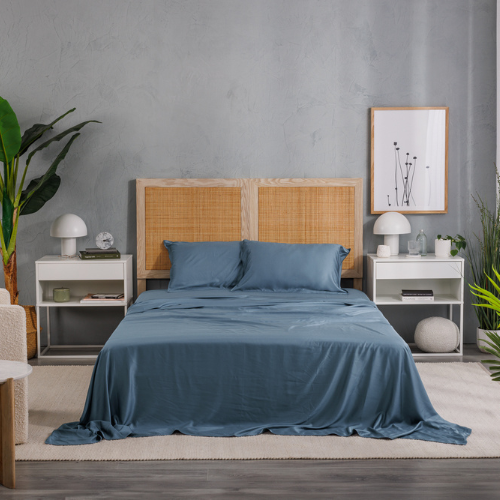If you’ve ever lain awake with thoughts circling like restless birds, you know the frustration of craving sleep but not finding it.
The truth is, better sleep doesn’t start at midnight. It begins with how you prepare your mind, body, and environment long before your head touches the pillow.
Mindfulness for sleep is more than a meditation practice. It’s an intentional way of living that gently guides your nervous system out of “go mode” and into rest. And when paired with a sleep environment that truly supports your body, it can transform not only how you fall asleep but also how you wake up.
The Science Behind Mindfulness and Sleep
When stress builds, your body’s sympathetic nervous system keeps you wired and alert.
Mindfulness practices (whether a simple breath or a guided meditation) activate the parasympathetic system, the “rest and digest” state. This shift helps regulate heart rate, lower cortisol, and prepare your body for the circadian rhythm’s natural dip into sleep.
But here’s the overlooked piece: your bedding can either support this natural rhythm or fight against it.
-
Overheated? Your body resists deep sleep.
-
Trapped moisture? You wake through the night.
-
Synthetic fibers? They disrupt your skin’s breathability.
Mindfulness soothes the mind; premium natural materials calm the body.
How to Style a Calmer Bedroom
Creating a mindful sleep sanctuary is about curating the physical space that surrounds you. A calmer bedroom tells your body: “This is where you rest.” Here’s how to bring that feeling to life:
1. Choose Colors That Calm the Nervous System
Soft, nature-inspired shades. Think muted greens, warm neutrals, or dusky blues as these tones encourage relaxation. These hues signal the brain to wind down, unlike bold or overly bright colors that can keep the mind alert.
Color psychology research shows that softer tones lower heart rate and blood pressure, while bright or high-contrast colors can keep the nervous system in “alert mode.”
2. Bring in Natural Materials That Breathe
The feel of your environment is as important as the look. Bedding made from natural fibers helps regulate temperature and wick away moisture, preventing the overheating and restlessness that interrupt deep sleep stages.
For a deeper dive, our guide to reasons why eucalyptus sheets are worth the price breaks down how premium fabrics work with your body to improve rest.
3. Prioritize Texture Over Clutter
A calming bedroom isn’t created by filling the space with more things, but by layering thoughtful details. A woven rug underfoot, curtains that filter light softly, or sheets with a silky, breathable finish all add texture and comfort without overwhelming the senses.
When it comes to bedding, it’s far more important to prioritize how fabric feels against your skin than to get caught up in chasing a so-called good thread count for sheets.
4. Light That Matches Your Body Clock
Lighting shapes your circadian rhythm just as much as the sun does. Swapping out harsh overhead bulbs for softer lamps, warm dimmers, or lights that mimic sunset tones can help signal to your body that it’s time to let go of the day.
Pair this with small changes, like cutting back on evening screen time and practicing a gentle digital detox before bed, and you’ll notice how much easier it becomes to unwind naturally.
5. Add Touchpoints That Encourage Mindfulness
Your bedroom should invite you to pause. A small journal by your bed for gratitude notes, a diffuser with calming essential oils, or a piece of art that feels soothing can all become quiet reminders that this is your time to restore.
6. Declutter and Unplug for Mental Rest
Even subtle clutter like cords, piles of books, or a glowing phone screen can keep the brain quietly stimulated.
Keeping surfaces clear, stowing chargers out of sight, and leaving your phone outside the bedroom are simple changes that help your mind associate the space only with calm and rest.
Mindfulness Strategies to Wind Down
A calm space sets the stage, but it’s your nightly rituals that help you step into rest. These mindfulness practices make the shift feel effortless.
1. Guided Breathing and Muscle Release
Try pairing deep breathing with a progressive muscle relaxation, softening tension from your jaw to your toes. It’s a way of telling your body: “You’re safe. You can let go.”
2. Visualization Rituals
Picture yourself in a calm sanctuary—a space with soft lighting, airy textures, and breathable sheets. By grounding your senses in tranquil imagery, you prepare your body to experience the same calm physically.
3. Gratitude Notes
Before bed, jot down three small gratitudes. It’s not just “positive thinking”—studies show gratitude lowers stress hormones and enhances sleep quality.
Bringing It All Together: Your Sleep Sanctuary
Mindfulness and environment work hand in hand: one calms the mind, the other comforts the body. When you combine small nightly rituals with a bedroom that feels calm and inviting, sleep comes more easily and more naturally.
✨ Tonight, try pairing a mindful wind-down ritual with an environment that feels soft, breathable, and grounding. The result? Not just more sleep—but better sleep.
If you’re ready to take the next step in creating your sanctuary, explore Olive + Crate’s TENCEL™ eucalyptus bedding collection—crafted to help your body stay cool, comfortable, and calm, night after night.













